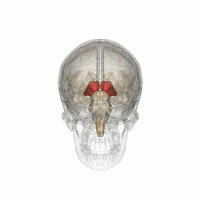Ust’-Ishim man created the Denisova bracelet
after having genetically met the Denisovans. May be this particular individual was still archaic. Klevius hasn't seen the full paper yet.By 'archaic' Klevius of course means modern like sapiens that roamed Eurasia before they got the better packed brain.
Nature 514, 445–449 (23 October 2014): The 45,000 year old Ust’-Ishim genome shares more alleles with non-Africans than with sub-Saharan Africans. When an ~8,000-year-old genome from western Europe (La Braña)9 or a 24,000-year-old genome from Siberia (Mal’ta 1)10 were analysed, there is no evidence that the Ust’-Ishim genome shares more derived alleles with present-day East Asians than with these prehistoric individuals (|Z| < 2). This suggests that the population to which the Ust’-Ishim individual belonged diverged from the ancestors of present-day West Eurasian and East Eurasian populations before—or simultaneously with—their divergence from each other. The finding that the Ust’-Ishim individual is equally closely related to present-day Asians and to 8,000- to 24,000-year-old individuals from western Eurasia, but not to present-day Europeans, is compatible with the hypothesis that present-day Europeans derive some of their ancestry from a population that did not participate in the initial dispersals of modern humans into Europe and Asia.
Peter Klevius comment: This is perfectly in line with a dispersal of the truly modern intelligent human out of Siberia and hybridizing with pre-existing (but dumb) archaic sapiens closer to Africa (on the map below the gray "bastard belt" as Klevius uses to put it). The other extreme (Australia, Papua N-G, Melanesia etc) was the starting point for Denisovan - not the end point as most erroneously still seem to think.
What Klevius wrote
Friday, May 02, 2014
Klevius Out-of-Siberia theory again gets strong support - while news media misinform and confuse
Yes, there was no big difference in intelligence between Homo sapiens and Homo neanderthalensis - until something big happened in cold Siberia/Altai
Here's a blatantly false and misleading "news" story
And here's a more accurate one
Klevius explanation: The keyword is 'early' in 'early modern humans'. This 'early' was missing from Guardian's reporting which then gives the impression that Neanderthals were equally clever as we. They were not, and this is extremely clear from what we know so far about their material culture. However, from the perspective of Klevius' theory (see below) this is really the crucial point that Klevius has challenged since he published his book Demand for Resources - on the right to be poor in 1992 (admittedly not a big hit) where he questioned why big brained Homos (e.g. the 1,400cc female Jinnuishan skull) living in China more than 260,000 bp didn't manage to leave more and better cultural traits than they actually did.
The simple reason why the Eurasian art track goes first to the west has to do with the more favorable climatological and faunal situation on this part of the Eurasian steppe. Sadly, it then encountered what is now called Europe and therefore became "racist" in the minds of biased "scientists". But luckily, at least it didn't start in Europe if we have to believe Klevius.
The Neanderthal inhabitants of El Sidrón (Spain) 49,000 years ago possessed a modern FOXP2 gene compared to the one in chimpanzee. It is then likely that Floresiensis/Denisovan got the same gene before their jungle dwarfing somewhere between SE Asian mainland and Australia. FOXP2 differs from that of the chimpanzee in two positions (911 and 977 of exon 7). Morphologically it should be noted that the shape of the human trapezoid bone indicates a derived feature from some 7-800,000 years ago and is a synapomorphy of H. sapiens and Homo neanderthalensis. The Homo floresiensis type specimen (LB1) includes a trapezoid, scaphoid, and capitate which display none of the derived features of H. sapiens and H. neanderthalensis but are morphologically identical to all African apes and Australopithecus afarensis. A possible explanation to both these facts is that a Pan/Homo hybrid in Africa got the modern FOXP2 more than 800,000 bp, and subsequently transferred it to the predecessor of Neanderthal and Denisovan. However, this hypothetical hybrid lacked the morphological features above, so in SE Asia it was more like an ape than a Homo except for that it possessed the crucial FOXP2 gene.
According to Peter Klevius theory - which is the only one yet that fits all physical known facts - a small but better structured Floresiensis like brain developed in a tropical climate as a result of so called jungle dwarfing and later on spread (while also growing in size) to the cold north where it eventually encountered and mixed with the biggest (normal) Homo skulls ever found. The Denisova cave and its surroundings in Siberia/Altai has not only proven to be the only known region inhabited by all known varieties of human lineages, but also the very place where the oldest truly sophisticated artifact made by truly modern humans has been found, the >40,000 bp so called Denisova bracelet.
From the media: The Neanderthals are believed to have lived between roughly 350,000 and 40,000 years ago, their populations spreading from Portugal in the west to the Altai mountains in central Asia in the east. They vanished from the fossil record when modern humans arrived in Europe.
The reasons for the demise of the Neanderthals have long been debated in the scientific community, but many explanations assume that modern humans had a cognitive edge that manifested itself in more cooperative hunting, better weaponry and innovation, a broader diet, or other major advantages.
Roebroeks and his colleague, Dr Paola Villa at the University of Colorado Museum in Boulder, trawled through the archaeological records to look for evidence of modern human superiority that underpinned nearly a dozen theories about the Neanderthals' demise and found that none of them stood up.
"We found no data in support of the supposed technological, social and cognitive inferiority of Neanderthals compared to their modern human contemporaries," said Wil Roebroeks, an archaeologist at the Leiden University in the Netherlands.
"The explanations make good stories, but the only problem is that there is no archaeology to back them up,"
"The evidence for cognitive inferiority is simply not there," said Villa. "What we are saying is that the conventional view of Neanderthals is not true."
Klevius comment: No not at all, it's the conventional view on the modern human that isn't true! And the reason for that is the fanatic push for the unfounded "out-of-Africa" myth which has been kept alive by squeezing in non-human fossils under the laughable title "anatomically modern human". And the only reason seems to be racist African-centrism aided by a "let's call the most backward continent the origin of humanity". In fact, it was Arabic islam that made Africa backward for 1400 years with its racist/sexist "infidel" slave raiding/trading!
A brief summary of Klevius' theory with some remarks on racial etc bias
For some twenty years Klevius has proposed the view that modern humans got a small but more efficient brain in the south (jungle?) but that they peaked culturally in the cold and challenging but also rewarding north where they got a bigger brain by mixing with pre-existing Homos. Neanderthals contributed with big skulls and erectus with mongoloid traits. We do know that Floresiensis possessed a brain that was much smaller than erectus' brain yet managed to produce similar culture. What is today called Indonesia happened to have the perfect breeding environment for the brain experiment that produced both Floresiensis and Denisovan: Jungles which, due to sea level changes, altered between islands and mainland. When mainland Floresiensis/Denisovans mixed with erectus (Red Deer Cave people might have been such a hybrid) they improved the brain qualities of erectus while getting erectus' mongoloid traits for cold adaptation (assuming erectus got it in their initial expansion to the north as well) and later on brought it south). Somewhere in the Altai region they also encountered northern Neanderthals which further enlarged their heads and produced a very smart modern human (compare the Denisova bracelet) which then started a successful back migration in all directions which strengthened the mongoloid traits in the already mongoloid east while mongoloid traits were diluted when mixing with non-mongoloids in the west and southwest (Neanderthal and archaic sapiens hybrids) and later on by the neolithic expansion. This explains the general racial pattern and also why we have "skinny" mongoloids both in the south and north although the original northern mongoloid were presumably "fatty" for the cold (compare Venus figurines, steatopygia etc).
Klevius personal note: It's extremely important to distinguish between PC cultural "race" terms and evolutionary traits. I call myself as belonging to the "bastard race", i.e. not a Saami, Scandinavian, Finn or Swede, but with a lot of mongoloid genetic traits in common with them or their predecessors. With a dad born in Gothenburg and a Finnish mother born in Helsinki who delivered me in Stockholm, and with a bilingual upbringing in Finland to a culturally ethnic Atheist Finland-Swede working in both Finland and Sweden, I rather emphasize my ethnicity under the 1948 Universal Human Rights declaration. Which fact effectively keeps my logic out of sexist and racist ranting about my ethnicity/race that would otherwise make it more difficult to produce scientific theories in this field.
Funny, but somehow I never even reflected over other "races" as being "inferior" or "different" as human beings or anything before these self-declared cultural "races" themselves started implying that I also possessed a "race" and that that "white" "race" was a "racist" "race". Had no idea really and in the 1990s while living in Finland and after visiting some "black" and "colored" Swedes in Stockholm our child thought Swedes were black in general.
Higher ape/hominid evolution in continental Africa vs. island SE Asia
Already before the discovery of Homo floresiensis Klevius thought a good "pygmy" brain slowly traveled to the protein rich but cold north while increasing in size and capabilities. After the discovery (2004) of the apelike and extremely small brained but smart Homo floresiensis in southern Indonesia nothing except M130 connected anything to Africa anymore. And when the Denisovan was discovered in Siberia at the same place as the hitherto most sophisticated early artifact ever found (Denisova bracelet - see above) the picture seemed quite clear. There are only two possible places for equatorial evolution of hominids, either Africa or SE Asia. And because SE Asian archipelago offers the by far best combination of jungle isolation and changing barriers it seems that floresiensis (and similar populations) should have been equally expected as the dwarfed elephants they hunted.So when a floresiensis like population managed to escape to mainland Asia they started mixing with local Homo erectus all the way up until they met with the northern Neanderthals and there created what became the truly modern humans - overwhelmingly proven through stunning skills revealed in unprecedented art and behavior.
M130
Sima de los Huesos, Floresiensis and Denisovan
may have all originated in EurasiaGenetic evidence reveals that the Sima de los Huesos hominin (400,000 bp) shared a common ancestor with Denisovan some 7-800,000 bp rather than with Neanderthal although its skeletal remains carry Neanderthal-derived features.
Do note the lack of chin in these as well as in the 26,000 bp Venus of Brassempouy. Also note that we don't know the shape of Floresiensis' nose.
The Sima sample exhibits a number of features that are shared with Neanderthals but not African fossil humans, and are rare in recent humans.
Later Neanderthals do not have the same diversity as earlier Neanderthals in western Europe, while central Asian Neanderthals have more diversity than those from Europe. This may indicate that Neanderthals were more numerous in western or central Asia.
The Denisovan nuclear DNA is also closer to Neanderthals than the Denisovan mtDNA.
Sima de los Huesos is closely related to the lineage leading to mitochondrial genomes of Denisovans.
The Denisovan-heidelbergensis clade split about 800kya-900 kya (around the time of the oldest stone tools on the island of Flores where floresiensis was found) is older than the modern human-Neanderthal split. Non-African Homo has an Erectus connection, a Denisovan-heidelbergensis connection, as well as a Neanderthal connection.
For a background to Klevius' theory see previous postings and Out of Africa as Ape/Homo hybrids and back as global Mongooids
First and third from the left are Red Deer Cave people 14,300-11,500 years ago. Second and fourth the so called Venus from Brassempuoy in France 25-26,000 years ago. The last pic is a reconstruction of a 1.9 Million year old Homo rudolfiensis skull. They all had flat broad cheeks, no chin and rounded forehead.
From the left: Red Deer Cave, Sami, Cro-Magnon
Was the sculptural portrait of Venus of Brassempuoy made because she looked so different from Cro Magnon? Was she kept as a pet or something by her Cro Magnon captors?
There were certainly completely different looking modern humans living in Eurasia side by side some 26,000 years ago. And the only way to make sense of these enormous differences is Klevius hybridization theory, i.e. that the modern brain came from small ape-like creatures (compare the "scientists" who didn't believe that the small Homo floresiensis brain could be capable of tool-making, fire-making etc..
Venus of Brassempuoy, one of the world's oldest real portrait
(this one slightly retouched by Klevius)
 The
Red Deer Cave people, discovered in southern China and who lived some
14,300-11,500 years ago had long, broad and tall frontal lobes behind
the forehead, which are associated with personality and behavior.
However, they also express prominent brow ridges, thick skull bones,
flat upper face with a broad nose, jutting jaws and lack a humanlike
chin. Their brains were smaller than modern humans and they had large
molar teeth (just like Denisovan), and short parietal lobes at the top
of the head (associated with sensory data). According to Curnoe, "These
are primitive features seen in our ancestors hundreds of thousands of
years ago".
The
Red Deer Cave people, discovered in southern China and who lived some
14,300-11,500 years ago had long, broad and tall frontal lobes behind
the forehead, which are associated with personality and behavior.
However, they also express prominent brow ridges, thick skull bones,
flat upper face with a broad nose, jutting jaws and lack a humanlike
chin. Their brains were smaller than modern humans and they had large
molar teeth (just like Denisovan), and short parietal lobes at the top
of the head (associated with sensory data). According to Curnoe, "These
are primitive features seen in our ancestors hundreds of thousands of
years ago".  This Cro Magnon could have been the captor of Venus of Brassempouy.
Compare e.g. his protruding chin with the retracting one on Venus of
Brassempouy. And keep in mind that the human chin has been an elusive
and quite recent feature in human evolution. The delicate features we
used to attribute to anatomically modern human while simultaneously
attributing high intelligence may, in fact, not be connected at all.
Slender and delicate skeletal features are not always connected with
high cultural achievement. Quite the opposite when looking at skeletal
remains outside the Aurignacian area..
This Cro Magnon could have been the captor of Venus of Brassempouy.
Compare e.g. his protruding chin with the retracting one on Venus of
Brassempouy. And keep in mind that the human chin has been an elusive
and quite recent feature in human evolution. The delicate features we
used to attribute to anatomically modern human while simultaneously
attributing high intelligence may, in fact, not be connected at all.
Slender and delicate skeletal features are not always connected with
high cultural achievement. Quite the opposite when looking at skeletal
remains outside the Aurignacian area..






















































































































































No comments:
Post a Comment